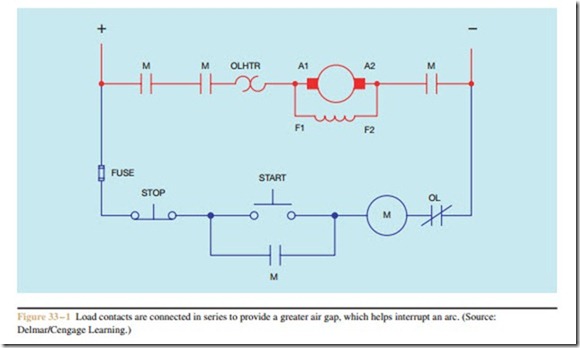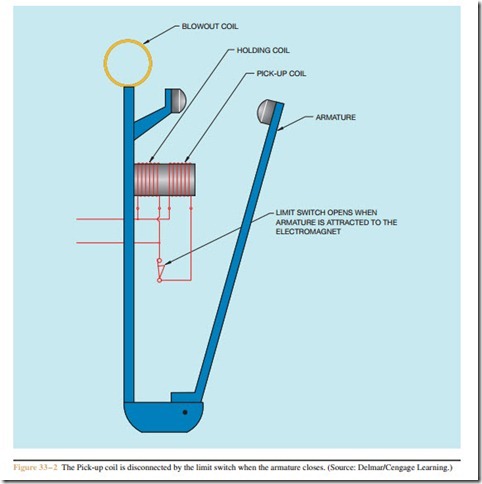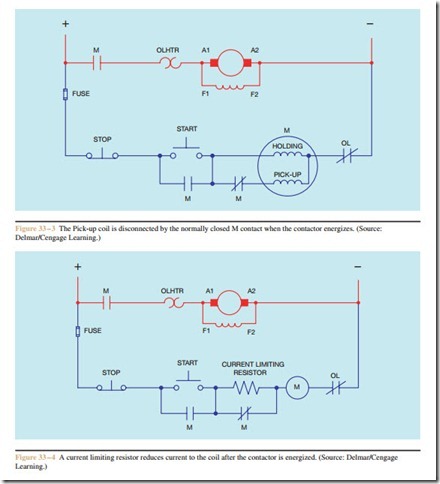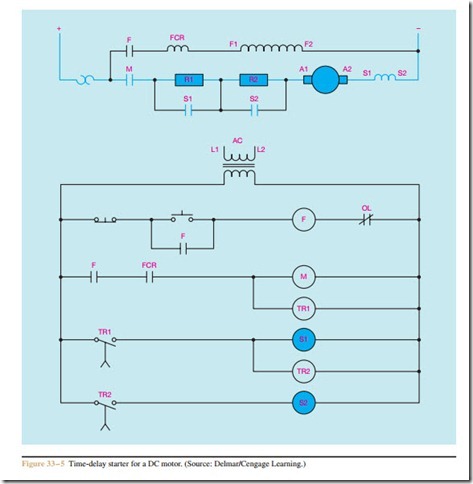Small DC motors are often started directly across- the-line because they have low inertia, which permits them to gain speed quickly, causing a rapid increase of counter-EMF to limit in-rush current. Fractional horse- power manual starters and magnetic starters that are generally used to control small AC motors are often employed to start small DC motors. Although only one load contact would be required to break the circuit and stop the motor, load contacts are often connected in series (Figure 33 – 1). Direct current is more difficult to interrupt than alternating current because it does not fall to zero at periodic intervals. Connecting the load contacts in series increases the total air gap between contacts and aids in interrupting an electric arc.
Contactors that are designed to control direct cur- rent devices are generally of the clapper type because those exhibit a greater air gap between the movable and stationary load contacts. Because of the distance the armature must travel, these contactors often contain two coils connected in parallel. One coil is called the pick- up coil and the other is called the holding coil. The pick-up coil is designed for momentary duty only and
the holding coil is designed for continuous duty. When the contactor is energized, both coils operate to create a strong electromagnetic field. When the armature closes, the pick-up coil is disconnected and the armature is held in place by the holding coil. Some of these contactors are equipped with a small limit switch that opens the circuit when the armature closes, Figure 33 – 2. Other dual coil contactors depend on a normally closed contact to disconnect the pick-up coil when the contactor is energized (Figure 33 – 3). When the Start button is pressed, a circuit is complete through the normally closed M contact to provide power to both the Holding coil and Pick-up coil. When the contactor energizes, the normally closed contact opens and disconnects the Pick-up coil. The Holding coil provides a magnetic field of sufficient strength to keep the armature closed.
Another common method of momentarily providing a strong magnetic field during pick-up and then reducing the current flow to the coil is to insert a current limiting resistor in series with the contactor coil (Figure 33 – 4). When the Start button is pressed, the normally closed contact provides a path around the current limiting resistor, permitting full voltage to be applied to the coil. When the contactor energizes, the normally closed contact opens, inserting the current limiting resistor in series with the coil.
When large DC motors are to be started, current in- rush to the armature must be limited. One method of limiting this current is to connect resistors in series with the armature. When the armature begins to turn, counter-EMF is developed in the armature. As counter- EMF increases, resistance can be shunted out of the armature circuit, permitting the armature to turn at a higher speed. When armature speed increases, counter- EMF also increases. Resistance can be shunted out of the circuit in steps until the armature is connected directly to the power line.
Limiting the starting current of the armature is not the only factor that should be considered in a DC control circuit. Most DC motor control circuits use a field current relay (FCR) connected in series with the shunt field of the motor. The FCR insures that current is flowing through the shunt field before voltage can be connected to the armature.
If the motor is running and the shunt field opens, the motor will become a series motor and begin to increase rapidly in speed. If this happens, both the motor and the equipment it is operating can be destroyed. For this rea- son, the shunt field relay must disconnect the armature from the line if shunt field current stops flowing.
The circuit shown in Figure 33 – 5 is a DC motor control with two steps of resistance connected in series with the armature. When the motor is started, both
resistors limit current flow to the armature. Time-delay relays are used to shunt the starting resistors out of the circuit in time intervals of five seconds each until the armature is connected directly to the line.
The circuit operates as follows: When the START button is pushed, current is supplied to relay coil F and all F contacts change position. One F contact is connected parallel to the START button and acts as a holding contact. Another F contact connects the FCR and the shunt field to the line.
When shunt field current begins to flow, contact FCR closes. When contact FCR closes, a circuit is completed to motor starter coil M and coil TR1. When starter M energizes, contact M closes and connects the armature circuit to the DC line. Five seconds after coil TR1 energizes, contact TR1 closes. This permits current to flow to relay coils S1 and TR2. When contact S1 closes, resistor R1 is shunted out of the circuit. Five seconds after relay coil TR2 energizes, contact TR2 closes. When contact TR2 closes, current can flow to coil S2.
When contact S2 closes, resistor R2 is shunted out of the circuit and the armature is connected directly to the DC power line.
When the STOP button is pushed, relay F de- energizes and opens all F contacts. This breaks the circuit to starter coil M, which causes contact M to open and disconnect the armature from the line. When coil TR1 de-energizes, contact TR1 opens immediately and de-energizes coils S1 and TR2. When coil TR2 de-energizes, contact TR2 opens immediately and de-energizes coil S2. All contacts in the circuit are back in their original positions, and the circuit is ready to be started again.
1. Why are contacts often connected in series when controlling small DC motors?
2. Why is direct current more difficult to interrupt than alternating current?
3. Why are clapper type contactors generally used to control DC devices?
4. When a contactor employs the use of dual coils, how are the holding and pick-up coils connected in relationship to each other?
5. How is the in-rush current to large DC motors often limited?
6. What is the purpose of the FCR?
7. How is the FCR connected in relationship to the shunt field?
8. Is the FCR a current relay or a voltage relay?
9. Refer to Figure 33 – 5. What would be the action of the circuit if timers TR1 and TR2 were to be replaced with off-delay timers?



